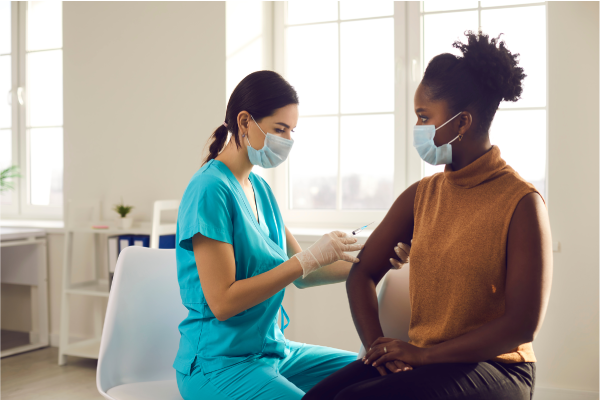The COVID-19 pandemic has pushed clinical research into the public limelight. While the COVID-19 clinical trials have made some efforts to enroll a diverse population, Black and Indigenous People of Color (BIPOC) are still dramatically underrepresented.1 Clinical care and public health policies are shaped by the outcomes of clinical research studies, making this an opportune time to understand the role of Institutional Review Boards (IRBs) in clinical research. IRBs play a critical role in the oversight of clinical research.
IRBs play a critical role in the oversight of clinical research. The essential role of the IRB is to protect the rights and welfare of human research participants – those who agree to participate in the testing of new therapies to help determine whether they are safe and effective. As such, the IRB:
- Works to prevent breaches of trust that have historically impacted equitable participation in clinical research;
- Helps researchers adhere to federal and local guidelines for the appropriate conduct of clinical research;
- Plays a key support role in the development of new medical technologies; and
- Ensures the informed consent process is comprehensive and provides necessary and understandable information to research participants.
Why Representation in Clinical Research Matters
It is critical to draw a distinction between clinical research and medical treatment. While research is essential to establishing clinical standards of care, there are no guarantees of benefits to those who participate in clinical research. If there are communities missing from clinical research participation, there will be communities who fail to receive any potential benefit from that research. Representation in clinical trials improves the acceptability and applicability of the resulting clinical care. Research participants also report positive feelings as a result of knowing that they are contributing to the advancement of science and precision medicine more broadly and note that they can combat feelings of helplessness by taking action. Evidence also indicates that people who participate in research may experience better outcomes on average compared to those outside of a clinical trial just due to the additional care and attention they receive.2
Knowing more about the checks and balances in place and about the role of the IRB in maintaining participant safety and welfare can make people more comfortable with the idea of research participation, and may contribute to improving diverse representation and making under represented communities more willing to consider research participation.
Medical Mistrust: A Barrier to Participation in Medical Research
Medical mistrust has a substantial impact on the availability of care, representation in research, and subsequent generalizability of research results. In other words, the mistrust that drives BIPOC away from research also renders research results that may not be accessible or appropriate to BIPOC, further widening physical and mental health disparities. Unfortunately, this medical mistrust has become more evident in the wake of the COVID-19 pandemic. For example, BIPOC have exhibited higher rates of vaccine refusal, citing medical mistrust as a primary source of their reluctance.3

Medical mistrust stems from systemic racism in the healthcare system and has resulted in the mistreatment of BIPOC. Underrepresented communities, including BIPOC, have been underserved by the healthcare system throughout the pandemic, facing higher rates of morbidity and mortality. These disparities are not limited to the impact of COVID-19. BIPOC also see higher rates of maternal and infant mortality4 in the US when compared to white individuals. They are more likely to receive a late-stage cancer diagnosis with poorer outcomes. They are also more likely to suffer the effects of hypertension, type 2 diabetes, depression and other mental illnesses, as well as heart disease, when compared to their white counterparts.
These significant health disparities are often attributed to social determinants of health, access to healthcare, comorbidities and other factors. However, the lack of inclusion of minority communities in research impedes our understanding of both the contributors and the clinical and policy-based solutions to these disparities. This lack of representation of minority communities in research is often traced to mistrust resulting from the Tuskegee Syphilis Study. The Tuskegee Syphilis Study, launched in 1932 and continued for 40 years, focused on observing and recording the long-term harm of chronic, untreated syphilis in Black men. The study recruited participants under the guise of “free medical care.” Unfortunately, the real objectives of this study were withheld. Participants were observed, and underwent painful procedures such as spinal taps to collect data, as their health continued to decline. When effective antibiotics for syphilis became available in the 1940’s, treatment was withheld from the subjects to continue to observe the progression of their disease. Unethical conduct of this nature has a ripple effect, contributing to generational medical mistrust that extends to the clinical trial setting, influencing participant representation. Historical atrocities involving research created a greater need for research protections for participants and has led to a better system of oversight.
The challenge of making under-represented communities more willing to consider research participation is complex, involving decades of systemic racism that has contributed to under-representation in medical research. Further complicating the clinical research setting, healthcare professions are statistically less likely to speak with BIPOC patients about participating in research.5 Healthcare providers and clinical researchers that focus on serving BIPOC and other underserved populations have less access to research funding and resources,6 and the lack of representation of BIPOC in the healthcare professional setting has made facilitating change difficult.7 In acknowledging all these barriers to diverse participation in research, it is important to understand the role of the IRB in human research oversight.
The Role of the Institutional Review Board in the Protection of the Rights and Welfare of Research Participants
Part 1: Purpose
Today, clinical research is tightly regulated through the collaboration of multiple parties. These regulatory and organizational bodies work together to enforce a series of checks and balances, overseeing the rights, and welfare of research participants. While the IRB cannot ensure a participant’s safety in a clinical trial, its oversight provides a safeguard for participants who decide to participate in human research. The IRB serves a critical role in maintaining participant safety and welfare by conducting an independent review of the research. In clinical studies, researchers and sponsors can be limited by their own professional objectives and personal perspectives. While they may have the best interests of the participants at heart, the personal and professional aims they bring into the research setting may influence decision making and research conduct in a manner that impacts participant safety and welfare.
The independent review of clinical research by an IRB supports social and ethical accountability, assessing whether the risks involved in the research are reasonable for participants and ensuring the research is being conducted in a manner that will generate generalizable knowledge. Further, independent review effectively mitigates the impact this bias may have. Potential research participants should feel confident that these elements and other factors related to their safety and welfare have received careful evaluation during the independent review process implemented by the IRB and reach out to the IRB if they have further questions.
Part 2: Structure
These safeguards are echoed through the IRB’s purpose, as well as in its requirements for membership and research review. IRBs are structured to support representation of professionals and members of the community with different expertise and experiences that allow the group to consider each study under review.
The regulations require at least five members with varying backgrounds and diversity. The current regulations specifically require that the IRB consider having members on the Board that represent different races, ethnicities, genders, cultural backgrounds, as well as having members of the Board who are sensitive to issues such as community attitudes in an effort to promote respect for its advice and counsel in safeguarding the rights and welfare of human research participants.9
Additionally, each IRB must have at least one member whose primary concerns are in scientific areas, and at least one member whose primary concerns are in nonscientific areas.10 To maintain impartiality, the regulations also require at least one member who is not affiliated with the institution.11 The regulations prohibit those who have conflicts of interest from voting or participating in initial or continuing review of any project.12

Once the research is approved based on meeting the criteria for approval, the regulations require the IRB to review any changes in the research. IRBs are also required to conduct continuing review at least annually to ensure that the research continues to meet the criteria for approval.13 Furthermore, if there is a safety issue or the research has harmed a participant, the IRB reviews the problem to determine if the research team acted in a manner that increased the risk to subjects or an unanticipated problem has occurred. With these IRB-facilitated checks and balances in place, people can feel assured that an independent group is overseeing participant safety and welfare throughout the duration of a clinical trial.
Criteria for the IRB Approval of Research
In addition to the regulations established to create a sense of diversity and impartiality within the IRB, the regulations also establish the criteria needed for research to be approved. Under these criteria, the research must ensure that
(1) The risks to participants are minimized;
(2) The risks are reasonable in relation to the anticipated benefits (to the participant and/or to scientific knowledge);
(3) There is equitable selection when recruiting participants to a clinical trial;
(4) Informed consent and its documentation must be sought by each participant unless an exception applies;
(5) The data must be monitored to help ensure participant safety;
(6) Confidentiality and privacy of participants must be maintained; and
(7) Additional safeguards must be in place when involving vulnerable populations such as children, individuals with impaired decision-making capacity, pregnant women, prisoners, and economically or educationally disadvantaged individuals.
Paraphrased from the full regulatory criteria14
Conclusion
Representation of diverse groups in clinical research is critical to improving health outcomes for individuals and communities. IRBs make up one part of a dynamic review process, designed to protect the rights and well-being of research participants.
Understanding the system that is in place for the oversight of clinical research studies, and the roles of the different people and committees that are part of the research oversight system, may help to answer questions and to make people more comfortable with the idea of research participation, which can help move toward the goal of diversity and equitable representation in human participant research. Learn more about WCG’s IRB services today.
References
- Artega S, Kates J, Michaud J, and Hill L. Racial Diversity within COVID-19 Vaccine Clinical Trials: Key Questions and Answers. KFF, January 26, 2001.
- Nijjar, SK, D’Amico, MI, Wimalaweera, NA, Cooper, NAM, Zamora, J, Khan, KS. Participation in clinical trials improves outcomes in women’s health: a systematic review and meta-analysis. BJOG 2017; 124: 863– 871.
- Thompson HS, Manning M, Mitchell J, et al. Factors Associated With Racial/Ethnic Group–Based Medical Mistrust and Perspectives on COVID-19 Vaccine Trial Participation and Vaccine Uptake in the US. JAMA Netw Open. 2021;4(5):e2111629. doi:10.1001/jamanetworkopen.2021.11629
- https://www.cdc.gov/coronavirus/2019-ncov/community/health-equity/racial-ethnic-disparities/disparities-deaths.html
- Bridges KM. Implicit Bias and Racial Disparities in Health Care. Human Rights Magazine; Vol. 43, No. 3: The State of Healthcare in the United States
- Hamel LM, Penner LA, Albrecht TL, Heath E, Gwede CK, Eggly S. Barriers to Clinical Trial Enrollment in Racial and Ethnic Minority Patients With Cancer. Cancer Control. 2016;23(4):327-337. doi:10.1177/107327481602300404
- Woolston C. Minority representation in US science workforce sees few gains. Nature, April 2021. https://www.nature.com/articles/d41586-021-01089-6
- https://www.accessdata.fda.gov/scripts/cdrh/cfdocs/cfcfr/cfrsearch.cfm?fr=56.107;
- https://www.accessdata.fda.gov/scripts/cdrh/cfdocs/cfcfr/cfrsearch.cfm?fr=56.107; https://www.hhs.gov/ohrp/regulations-and-policy/regulations/45-cfr-46/revised-common-rule-regulatory-text/index.html#46.107
- https://www.hhs.gov/ohrp/regulations-and-policy/regulations/45-cfr-46/revised-common-rule-regulatory-text/index.html#46.107; https://www.accessdata.fda.gov/scripts/cdrh/cfdocs/cfcfr/cfrsearch.cfm?fr=56.107
- https://www.accessdata.fda.gov/scripts/cdrh/cfdocs/cfcfr/cfrsearch.cfm?fr=56.107; https://www.hhs.gov/ohrp/regulations-and-policy/regulations/45-cfr-46/revised-common-rule-regulatory-text/index.html#46.107
- https://www.hhs.gov/ohrp/regulations-and-policy/regulations/45-cfr-46/revised-common-rule-regulatory-text/index.html#46.107; https://www.accessdata.fda.gov/scripts/cdrh/cfdocs/cfcfr/cfrsearch.cfm?fr=56.107
- https://www.hhs.gov/ohrp/regulations-and-policy/regulations/45-cfr-46/revised-common-rule-regulatory-text/index.html#46.111; https://www.accessdata.fda.gov/scripts/cdrh/cfdocs/cfcfr/CFRSearch.cfm?CFRPart=56&showFR=1&subpartNode=21:1.0.1.1.22.3 ; https://www.fda.gov/media/83121/download
- Paraphrased from the full regulatory criteria, which are available at https://www.hhs.gov/ohrp/regulations-and-policy/regulations/45-cfr-46/revised-common-rule-regulatory-text/index.html#46.111; https://www.accessdata.fda.gov/scripts/cdrh/cfdocs/cfcfr/cfrsearch.cfm?fr=56.111
*Alisha Rodenbach’s current position is: Assistant General Counsel at Multicare Health System
Don't trust your study to just anyone.
And we’re the best for a reason. Experience the WCG difference starting with a free ethical review consultation. We’re here to help you streamline, alleviate, and accelerate.
